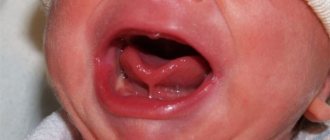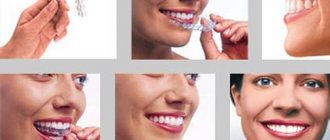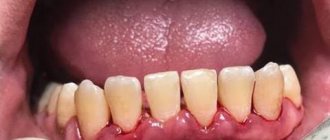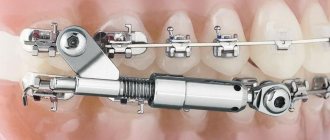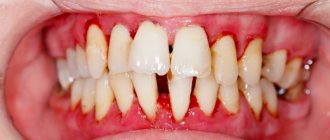5097
The final stage of correcting the bite and aligning the elements of the dentition is wearing retention devices.
It is not recommended to ignore the use of aligners, retainers or plates after removing braces, even when correcting minor defects, since the effect of a long main treatment period will be short-lived.
Most often, specially designed mouthguards are used to consolidate the results obtained, since the devices have many advantages compared to other devices.
Consolidate the result
You've removed your braces and are now sporting a Hollywood smile. But it won’t last long if you don’t consolidate the results. Our body is insidious, and at the slightest change it resists.
Teeth freed from braces strive to take their usual place, and in the absence of support and fixation, they will quickly take the position that you have been getting rid of for so long with the help of braces.
The purpose of retention devices is to hold the elements of the dentition in the direction specified by the braces.
Mouthguards are usually worn twice as long as braces. Often they get by with a similar period. The minimum period is one and a half years. In rare cases, a mouthguard may need to be worn for many years.
The retention period, that is, the time for consolidation of the result, depends mainly on three factors:
- Age. As a rule, treatment of malocclusion in children is faster, easier and more effective. The older the patient, the longer the main treatment period and recovery period.
- Type and complexity of pathology . The more pronounced the defects were, the more intense the resistance.
- Treatment time. After just a few months of treatment with braces, the maximum that we were able to achieve is visible. Braces are worn for two years, or even more. For what? So that the result does not disappear. The longer the treatment period, the more reliable it is.
Why wear mouth guards after braces?
Malocclusion, which is a consequence of a defect in the arrangement of teeth in the jaws.
Correcting such an anomaly is difficult and treatment is not limited to wearing braces. During the entire time the structure is installed, the teeth take the correct position under mechanical pressure on them. Previously, dentists believed that such therapy was enough - after all, the dentition had become straight. However, observations of patients have confirmed that without external influence, the teeth gradually begin to return to their previous location.
Using a dental guard after braces helps hold the teeth in place until they are completely fixed in their new position. The duration of the retention stage, as a rule, exceeds the period of wearing braces twice.
General overview of devices
The device looks like a thin transparent “case” for the elements of the dentition, completely repeating their shape. The mouth guard fits tightly to each tooth and holds it in the position specified by braces.
Modern mouthguards are made from medical polymers. The material is completely safe and does not cause allergies. Most often, manufacturers use compositions based on polyurethane or silicone.
This is perhaps the most comfortable orthodontic device. The mouthguard does not pinch or cause pain, practically does not interfere with speaking, and is almost invisible. You can't just eat with her.
You get used to this lightweight and convenient device quite quickly. The adaptation period is up to two hours.
Carefully! The product is very fragile and can easily crack in the mouth. Do not store the device in random places not intended for this purpose; it may be accidentally crushed.
Individual devices tend to wear out, become softer, and become looser. Six months after purchase, it will no longer support teeth and lose effectiveness.
You don't know what to do when your teeth move apart after braces? Let's figure it out together.
Read here how long you should wear retainers after braces.
At this address https://orto-info.ru/sistemyi-vyiravnivaniya-zubov/kappyi-elayneryi/chto-takoe-invisalign.html the smallest details about Invisalign aligners.
General overview
The duration of orthodontic correction depends on the severity of the defects and ranges from one and a half to two years. All this time, the installed device, the configuration of which provides for the presence of a power arc, creates a force sufficient to displace the problem units in a given vector. However, the dentofacial apparatus is designed in such a way that after giving the tooth the required alveolar position, the probability of its return to its original position remains high. A retention mouthguard is a product that eliminates such an outcome.
Operating principle
The essence of wearing a retention mouthguard is to fix and maintain the teeth in the desired position. The device does not expand or straighten anything - the braces have already done that.
Thus, the teeth “learn to live independently,” and after all orthodontic treatments are removed, nothing will happen to them.
The device relieves tension in the jaw muscles, which prevents the preservation of the results of orthodontic treatment, and acts quite gently. In terms of strength and effectiveness, a mouthguard is somewhat inferior to a retainer.
The key to the effectiveness of mouth guards is regular wearing, according to the doctor’s recommendations. You should use the device for at least several hours every day. A break even for a day is undesirable.
Features of the retention period
Duration. The period of use of retention devices is determined by the treating orthodontist. The more the dental system has been changed, the longer it will be. Additionally, it is influenced by the state of the dental system, the speed of adaptation of its tissues to the new position of the teeth, and other features. The retention period can last as long as the main phase of treatment, or longer.
Daily hygiene. This is done in the same way as when using braces. The constant use of metal plates fixed to the surface of the enamel can increase the risk of its demineralization, accumulation of soft plaque, and the appearance of tartar. To keep your teeth healthy, you need to visit the dentist once every six months for a preventive examination, professional hygiene, and enamel remineralization. These visits are combined with control examinations by an orthodontist, who can adjust the retention apparatus, change recommendations for its use, etc. If a non-removable retainer comes off, causes discomfort, etc., an orthodontist is visited urgently.
Additional treatment. Together with mouthguards or retainers, functional orthodontic devices (regulators, bionators, activators, etc.) can be used at the final stage of treatment. They are installed to finally align the position of the teeth while the adaptation process is underway.
During the retention period, the shape of the dentition no longer changes, and there will be no visible, noticeable results at this stage of treatment. It is important so that the teeth acquire a stable position, and the dental system itself successfully adapts to it.
Dentists at the Dentospas clinic use individually manufactured devices during the retention period, which ensures control over the stability of the teeth. This ensures that the results of orthodontic treatment will not be lost, and the patient’s smile will remain beautiful for a long time.
Varieties
In orthodontics, there are three types of retention aligners, differing in manufacturing method, material and effectiveness.
Standard
The cheapest devices. Conveyor products are produced not according to a cast, but according to a single sample. They are rarely used as a retention agent, since they relieve tension in the jaw muscles rather than fixing the elements of the dentition in their original position.
During production, individual characteristics are not taken into account, so they may be uncomfortable to wear.
Advantages such as transparency, invisibility, and compactness do not apply to a standard mouth guard. It is thick and without any “dental” relief. Reminds me of a horseshoe. It is very difficult to talk to her.
Pros:
- low price;
- strength and durability.
Minuses:
- uncomfortable;
- can only be worn at night;
- do not take into account the details of fragments of the dentition;
Most often, products are not used for retention therapy, unless the patient has ideal “standard” jaw bone shapes and minor occlusal defects have been corrected.
Thermoplastic
The models are made of a material that becomes pliable at high temperatures and hardens when cooled. Such products are also not made from casts, but are more convenient and individual.
How are they installed? First they put it in hot water and then put it on the patient’s teeth. The workpiece is cooled and finally takes the shape of all the elements (of course, without details).
Pros:
- low price;
- suitable for both primary treatment and retention;
- take into account the individual characteristics of the jaws;
- strength.
Minuses:
- not aesthetic;
- interfere with talking;
- the details are poorly worked out: in general, the jaw will remain straight, but individual teeth may move slightly.
Individual
Best suited for retention therapy. They are made strictly according to the patient's impression. The models are thin, compact, and do not cause any discomfort. During manufacturing, the smallest details of the dentition are taken into account. The products are transparent and almost invisible.
Pros:
- high efficiency;
- comfort;
- can be worn even around the clock;
- put on and take off without effort, and the mouthguard does not fall out on its own;
- doesn't interfere with talking.
Minuses:
- Fragility. It must be stored very carefully. Even light pressure can cause the mouthguard to crack.
- Softness. A thin polymer aligner cannot be compared with massive metal braces.
- Fragility. The individual device wears out quite quickly; it will have to be changed every few months.
Even with careful storage and wearing, the device loses strength over time, becomes loose and wears out.
Watch the video to see how custom retention aligners are made.
How to care for your mouthguards
A container is included to store the aligners. So that the structure does not break and is always clean. The only drawback of aligners is self-control when wearing them. If the patient ignores the doctor's instructions or forgets to put on a mouthguard, this affects the beauty of the smile. Keeping the structure clean is easy. You don't need special tools for this. First, proper oral hygiene. This will avoid the formation of stones and caries. Secondly, clean the record daily under running water or wash it with rinse aid. Do not leave the structure in the sun or wash it in hot water. At the appointment, the orthodontist will tell you about the rules of wearing and give recommendations on the use of aligners.
Advantages and disadvantages
We have just talked about most of them. Now let's summarize.
Pros:
- Relatively low price. After expensive braces, this is doubly pleasant.
- Safety. There have never been cases where wearing a mouthguard caused any unpleasant consequences. Theoretically, there is a possibility of allergies, but in practice this has not been observed.
- Compact and convenient. The mouthguard does not cause discomfort (of course, if you don’t leave it for a few days) and does not interfere with talking.
- Aesthetics and transparency . Most likely, no one will notice it except you.
Minuses:
- Fragility. The device is easy to deform.
- Softness . The device does not hold the elements of the dentition one hundred percent.
- Fragility. Most likely, you will change more than one aligner during treatment.
- The need for regular wearing and discipline.
- Some people need to wear a mouthguard for many years.
Operating principle and advantages
The most popular and convenient type of retainer is removable aligners. Elastic pads that completely follow the anatomical structure of the dentition and adjacent gums do not create pressure. Instead, they fit tightly into the surface, eliminating changes in the achieved position of individual teeth.
The devices are easy to use, do not harm tooth enamel, and thanks to their thin walls, do not affect diction and remain virtually invisible to others. Positive aspects noted by dentists and patients who have experience working with mouth guards in this category include:
- Aesthetics of designs;
- Ease of oral care;
- There is no risk of developing an allergic reaction.
Getting used to the design takes no more than a couple of hours, which is also due to the prolonged wearing of braces prior to its installation.
Wearing rules
They are prescribed by a doctor. Some wear the device constantly, others wear it for several hours a day. The “standard” recommendation is 10 hours.
It is better to associate wearing the device not with sleep, but with a certain period of the day. Who cares? - you ask. Big. Tested in practice. If you are told to wear a retention device ten hours a day, but you only wear it for five, then don’t complain about its low efficiency.
Wearing time may be reduced. For example, for the first year and a half you wear a mouthguard for ten hours, and then for six. This is again individual and determined by the doctor.
When to remove the mouth guard? If you are prescribed to wear a device full-time, you should only remove it to eat and brush your teeth.
The main thing is regularity. If you stop wearing the device ahead of time, a relapse will immediately begin. If you leave the device for at least a week and then try to put it on again, it will be difficult and painful.
Important! Your teeth will never be as beautiful as they were a couple of days ago. Remember how much effort, time and money you spent on braces.
You can’t eat with a mouthguard, not because it’s harmful, you just won’t be able to do it. The main thing is to remember to put it on again after eating!
Increased hygiene is required while wearing a mouthguard. Even if you have never had tooth decay in your life, it may appear after your braces are removed. Have it professionally inspected and cleaned regularly, and promptly remove any dark spots that appear.
When is the use of dental trainers and the price of the products justified?
In this article we will tell you how much aligners for teeth straightening cost for the entire treatment period.
Here https://orto-info.ru/ortodonticheskoe-lechenie/retentsionnyiy-period/tsena.html we’ll talk about the cost of installing permanent retainers.
Types of retention guards
Orthodontic products are classified according to three criteria: manufacturing method, wearing time and material of production. The attending physician decides which mouthguards will need to be used after removing braces. The orthodontist takes into account all the individual characteristics of the clinical picture and selects the most suitable model.
By manufacturing method
When correcting a bite, individual and thermoplastic mouth guards are used. The greatest effectiveness is observed in treatment with individual correctors, which are created using the cast method or using a special computer program. They fully correspond to the peculiarities of the location of the teeth, provide the necessary fixation and do not cause discomfort during use.
The second option is thermoplastic. The price for such mouthguards after braces in Moscow is lower, since the method of their manufacture is much simpler. Correctors are made from bioplastic, which has the ability to soften under the influence of elevated temperatures (hot water is used). The product is heated and placed on the patient’s teeth. As they cool, the trays take the desired shape.
By wearing time
Such correctors are divided into two types: night and permanent. Night models are recommended for minor defects, when, after removing the braces, the teeth do not need increased impact. They are not worn during the daytime.
The price for permanent retention aligners after braces is higher, since they are expected to be used around the clock and periodically replaced. It is not recommended to remove such products even at night. The exception is performing hygiene procedures.
According to the material of manufacture
Mouthguards are made from silicone or bioplastic. According to reviews, there is no significant difference between the materials. The quality and ease of use are influenced by the technology used to produce correctors.
The price for silicone mouth guards after braces is higher, since this material is used for individual products. Bioplastic is used primarily for thermoplastic mouth guards. The color of both types is transparent.
Care instructions
In order for the device to last a long time and the retention period not to be prolonged, it is recommended to adhere to some rules:
- Clean your device every day .
This can be done with a regular paste or a special solution. If you have a custom mouth guard with a complex texture, it will be difficult to wash it in hard-to-reach places. It is better to do this not with a regular brush, but with a special orthodontic one. It is smaller and its bristles are longer. You can purchase it at a specialty store or pharmacy. - Store in a special container. Typically, a U-shaped plastic case is provided with the mouthguard.
Develop the habit of always putting the device back in its place. The mouthguard is soft and thin, so it can easily become deformed, so it is not recommended to store it without a case. - Maintain integrity. Your jaw puts a huge strain on the device, not to mention improper storage.
Holes and cracks may appear on their own. If you notice that the polymer device is broken, cracked or worn out, buy a new mouthguard. A broken device becomes ineffective.
How long are mouth guards worn?
Only a specialist involved in the treatment of orthodontic pathology can tell you how long you will need to wear mouthguards. Each case is individual.
After the braces are removed, the results are diagnosed and further treatment is predicted.
The duration of therapy is determined by the following characteristics of the pathology:
- degree of complexity of bite pathology;
- age group of the patient (the older the person, the longer the duration of treatment);
- duration of the course of orthodontic treatment with braces;
- type of mouth guard (permanent/night).
Dentists are of the opinion that the longer the mouthguards are worn, the more accurate the result and the lower the risk of reverse deformation.
Individual mouth guards, which must be worn for 24 hours, are changed every 2–3 months. During the entire treatment, the patient may need up to 30–50 correctors. Replacing each product with a new one is necessary due to changes occurring in the dental composition in order to maintain the strength and direction of the impact of the structure on the teeth.
Prices
The table shows the average cost of various types of products per jaw.
| Product type | Cost in rubles | |
| Standard | 700—800 | |
| Thermoplastic | 200—300 | |
| Individual | silicone | 3 000 |
| polyurethane | 7 000—8 000 | |
At a lower price, standard and thermoplastic mouthguards can be ordered online, but in this case there is a risk that the model will not suit you, or there will be problems with delivery.
Features of operation
After removing braces, many patients, tired of the presence of the structure in the oral cavity, refuse to wear aligners, especially if they are permanent products. As a result, wearing braces becomes pointless, as the teeth move again.
The use of mouth guards should not be neglected. They have two main advantages over braces: comfortable use and invisibility on the teeth.
There may be some minor discomfort in the first 3-5 days as it takes time to get used to the presence of the product in the mouth. There may also be problems with diction. But as you adapt, all these minor shortcomings are eliminated.
The main advantage of modern mouth guards is their invisibility on the teeth. The transparent color and special design make it possible to hide the presence of the corrector so that even at a distance of several steps the interlocutor does not notice it.
Varieties of other retention removable devices
- Plate devices: retention plates are a device with metal or plastic arches and special holding devices. The design is more noticeable to others than mouthguards.
- Double-jaw retention devices: this type of retainer is used in cases of serious pathology and the need to work with all teeth at once. They are quite bulky and can combine the characteristics of both trays and plate devices.
